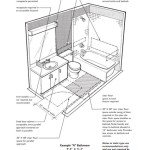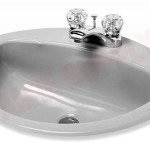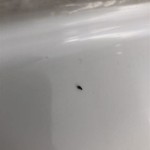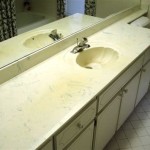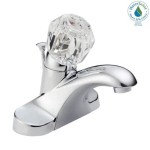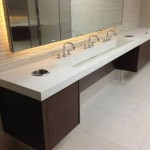Can You Vent A Bathroom Exhaust Fan In The Soffit?
The question of whether a bathroom exhaust fan can be vented into the soffit is a common one among homeowners undertaking bathroom renovations or experiencing ventilation issues. The seemingly straightforward nature of directing the exhaust into the soffit, often perceived as a conveniently located and easily accessible space, belies the potential problems and code violations that can arise from this practice. To understand the complexities of bathroom exhaust fan venting, a comprehensive exploration of building codes, airflow dynamics, and moisture management is required.
A bathroom exhaust fan serves the critical function of removing moisture-laden air from the bathroom. Showers, baths, and even everyday activities like washing hands contribute significantly to the humidity level within a bathroom. Without adequate ventilation, this excess moisture can lead to a host of problems, including mold and mildew growth, peeling paint, warped wood, and corrosion of metal fixtures. Proper ventilation is not merely a matter of convenience; it is essential for maintaining a healthy and structurally sound home. Therefore, the choice of how and where to vent the exhaust fan is a decision that demands careful consideration and adherence to established building practices.
Building codes, which vary by jurisdiction, are the primary determinant of acceptable and unacceptable venting practices. These codes are designed to protect public health and safety by ensuring that building systems function properly and do not create hazardous conditions. When it comes to bathroom exhaust fans, building codes typically specify where exhaust air can and cannot be discharged. The primary objective is to ensure that moist, contaminated air is directed away from the building's structure and other occupied spaces.
Why Venting into the Soffit is Generally Discouraged
Venting a bathroom exhaust fan directly into the soffit is generally strongly discouraged, and often prohibited by building codes. The soffit, the underside of the eaves that overhang the exterior walls of a house, is designed to provide intake ventilation for the attic. Its primary function is to allow fresh air to enter the attic space, promoting air circulation and helping to regulate temperature and humidity. Venting moist bathroom air into this space directly undermines the soffit's intended purpose and can lead to a range of problems in the attic.
One of the most serious concerns associated with soffit venting is the potential for moisture accumulation in the attic. Moist air from the bathroom, when released into the relatively cool attic environment, can condense onto the attic's surfaces, including the underside of the roof deck, insulation, and framing members. Over time, this condensation can saturate the insulation, reducing its effectiveness and leading to energy loss. The damp environment also creates ideal conditions for mold and mildew growth, which can compromise indoor air quality and potentially lead to health problems for the occupants of the house.
Furthermore, the structural integrity of the roof can be jeopardized by prolonged exposure to moisture. Wood rot, caused by fungal decay in damp wood, can weaken roof sheathing and framing, potentially leading to costly repairs. Metal fasteners, such as nails and staples, can corrode, further weakening the structure. The problem is exacerbated in colder climates, where the moisture can freeze and thaw, causing expansion and contraction that further damages building materials.
Another significant concern is the potential for backdrafting. If the attic is negatively pressurized, which can occur due to mechanical equipment such as furnaces or air conditioners, the moist air vented into the soffit can be drawn back into the living space. This can negate the intended function of the exhaust fan and potentially introduce contaminants into the occupied areas of the house.
Acceptable Venting Practices
To ensure proper ventilation and compliance with building codes, bathroom exhaust fans should be vented to the exterior of the building through a dedicated duct system. The most common and generally recommended practice is to vent the exhaust air horizontally through a wall or vertically through the roof.
Wall venting involves running the ductwork from the exhaust fan to an exterior wall and terminating it with a louvered vent cap. The vent cap should be positioned to direct the exhaust air away from the building and prevent it from being drawn back into the structure through windows, doors, or other openings. The ductwork should be properly insulated to prevent condensation within the duct, especially in colder climates. The vent cap should also include a backdraft damper to prevent outside air from entering the duct when the fan is not operating.
Roof venting involves running the ductwork vertically through the roof and terminating it with a roof vent cap. The roof vent cap should be designed to prevent water from entering the duct and to allow the exhaust air to escape freely. The ductwork should be properly sealed to prevent air leaks and insulated to prevent condensation. This method requires careful flashing around the vent cap to prevent water intrusion into the roof structure.
Regardless of whether wall venting or roof venting is chosen, the ductwork should be as short and straight as possible to minimize airflow resistance. Long, convoluted duct runs can significantly reduce the efficiency of the exhaust fan. The ductwork should also be properly sized to match the fan's airflow rating. Undersized ductwork can restrict airflow, while oversized ductwork can lead to condensation problems.
Alternative Considerations and Potential Exceptions
While venting into the soffit is generally discouraged, there might be rare and very specific circumstances where it could be considered, although this would require expert consultation and meticulous execution. For instance, if the soffit is specifically designed and constructed as a dedicated exhaust vent for a whole-house ventilation system, and if the design incorporates features to prevent moisture accumulation and backdrafting, it *might* be permissible. However, this scenario is extremely uncommon and would typically only be found in highly engineered and specifically designed ventilation systems.
Furthermore, some local jurisdictions may have specific codes or interpretations that address soffit venting. It is crucial to consult with local building officials or a qualified HVAC contractor to determine the specific requirements in a given area. What is acceptable in one jurisdiction may be a violation in another.
It is also important to note that simply adding a vent to an existing soffit is almost certainly not an acceptable solution. A proper venting system requires careful planning, design, and installation to ensure that it functions effectively and does not create problems in the attic.
In summary, the decision of whether or not to vent a bathroom exhaust fan into the soffit is not a simple one. While the practice may seem convenient, it is generally ill-advised due to the potential for moisture problems, code violations, and negative impacts on the building's structure and indoor air quality. Consulting with qualified professionals and adhering to local building codes are critical steps in ensuring a safe and effective bathroom ventilation system.

Everbilt 4 In To 6 Soffit Exhaust Vent Sevhd The Home Depot

Can Your Bathroom Fan Vent Into The Attic Or Soffit Beantown Home Improvements Inc

Adding A Bathroom Fan Fine Homebuilding

Do Your Exhaust Vents Terminate At Soffits Charles Buell Consulting Llc

Bathroom Venting Through Soffit Greenbuildingadvisor

How To Vent A Bathroom Fan Through Soffit 4 Step Guide Home Inspector Secrets

Soffit Bath Fan Ventilation Exterior Inspections Internachi Forum

Choosing The Right Vent Cap For A Soffit Primexvents

Home Moisture Flow Soffit Vent

Inspecting The Bathroom Exhaust Internachi
Related Posts
